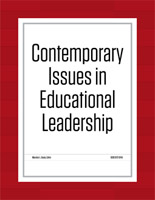Department of Educational Administration

Contemporary Issues in Educational Leadership
Date of this Version
1-3-2020
Document Type
Article
Citation
Contemporary Issues in Educational Leadership, 2:1 (2020)
ISSN 2472-9744 ; http://digitalcommons.unl.edu/ciel/
DOI: 10.32873/unl.dc.ciel.1012
Abstract
The U.S. Census indicates that Hispanic participation in postsecondary education tripled between 1996 and 2016. If the traditional outcome measure of the six-year graduation rate is used, however, increased participation has not resulted in an increased number of Latinos who complete a bachelor’s degree. Further, typical examinations of baccalaureate completion have focused on the starting point—beginning at a community college or beginning at a four-year college or university and compare percentages of completion by race or ethnicity. Findings of such studies point to the disparity in bachelor’s degree completion rates between Latinos and other racial and ethnic groups and that the disparity is even greater among individuals who begin postsecondary education at the community college. This paper follows an anti-deficit approach to gain a greater understanding of the complexities of baccalaureate completion of Latina/o students beyond the common measure of a six-year timeframe and the simplified starting point of the community college. Learning from the success of the participants may provide insight helpful to educational leaders who seek to provide access and facilitate the success of Latino students.
Included in
Bilingual, Multilingual, and Multicultural Education Commons, Educational Administration and Supervision Commons, Educational Leadership Commons, Higher Education Commons


Comments
Copyright © 2020 Brent D. Cejda.